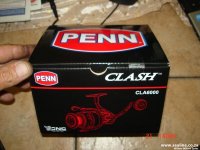willem wikkel spies
Moderator
The Penn Clash was specifically made for spinning
The Penn clash comes in sizes from 2000, 2500, 3000, 4000, 5000, 6000 and 8000.
As time allows me, I shall review most of the range.
This is my review of the Penn Clash 6000
It is indeed my first reel review as such, but it must be stated that I have 34 years fishing experience. I have put many reels through their paces and over the years I have seen and encountered good reels and bad reels. Cheap reels and expensive reels. It must be noted, that neither cheap or expensive reels will catch you the big trophy fish!
You as the angler is the one that will ultimately choose to target such a trophy fish, when you decide to do that, you need the right equipment to achieve your goal! I do not believe in the very top end range of reels as they are often too expensive and ultimately the sea has no remorse when it decides to eat away at your top end range reel. Looking at this line of fishing reel, I do believe that this reel has all bells and whistles to assist you in achieving your goal.
So lets fire away!
This reel will suit spinning fishing when looking for the bigger fish. I would use the Penn Clash 6000 for looking at targeting the bigger kingfish and Garrick on plugs and spoons from 2 ounce to 6 ounce or even bait fishing. Fishing from the shore or a boat the reel shall do the trick. If you decide to make it a 30lb setup, lighter spoons or plugs should also suit this reel. The reel is sold in a standard box, with an instruction manual, spares guide and a bag containing 2 spool washers to assist in line lay.
According to the specifications:
Gear ratio : 5,6:1 @ 41 inches per handle turn
Mono line capacity lbs/ yds : 15/ 335; 20/ 230 25/ 210
Braid capacity lbs/ yds : 30/ 490; 40/ 390 50/ 335
Weight : 21oz or 595 grams
Further:
Full aluminium body
Aluminium techno balanced rotor
Cnc gear tm, machined brass pinion and drive gear
HT-100 carbon fibre drag washers
8 sealed stainless steel ball bearings
Instant anti reverse bearing
Heavy duty aluminium bail wire
Super line spool
Line capacity rings
Max drag 25lbs
The Penn clash comes in sizes from 2000, 2500, 3000, 4000, 5000, 6000 and 8000.
As time allows me, I shall review most of the range.
This is my review of the Penn Clash 6000
It is indeed my first reel review as such, but it must be stated that I have 34 years fishing experience. I have put many reels through their paces and over the years I have seen and encountered good reels and bad reels. Cheap reels and expensive reels. It must be noted, that neither cheap or expensive reels will catch you the big trophy fish!
You as the angler is the one that will ultimately choose to target such a trophy fish, when you decide to do that, you need the right equipment to achieve your goal! I do not believe in the very top end range of reels as they are often too expensive and ultimately the sea has no remorse when it decides to eat away at your top end range reel. Looking at this line of fishing reel, I do believe that this reel has all bells and whistles to assist you in achieving your goal.
So lets fire away!
This reel will suit spinning fishing when looking for the bigger fish. I would use the Penn Clash 6000 for looking at targeting the bigger kingfish and Garrick on plugs and spoons from 2 ounce to 6 ounce or even bait fishing. Fishing from the shore or a boat the reel shall do the trick. If you decide to make it a 30lb setup, lighter spoons or plugs should also suit this reel. The reel is sold in a standard box, with an instruction manual, spares guide and a bag containing 2 spool washers to assist in line lay.
According to the specifications:
Gear ratio : 5,6:1 @ 41 inches per handle turn
Mono line capacity lbs/ yds : 15/ 335; 20/ 230 25/ 210
Braid capacity lbs/ yds : 30/ 490; 40/ 390 50/ 335
Weight : 21oz or 595 grams
Further:
Full aluminium body
Aluminium techno balanced rotor
Cnc gear tm, machined brass pinion and drive gear
HT-100 carbon fibre drag washers
8 sealed stainless steel ball bearings
Instant anti reverse bearing
Heavy duty aluminium bail wire
Super line spool
Line capacity rings
Max drag 25lbs

























